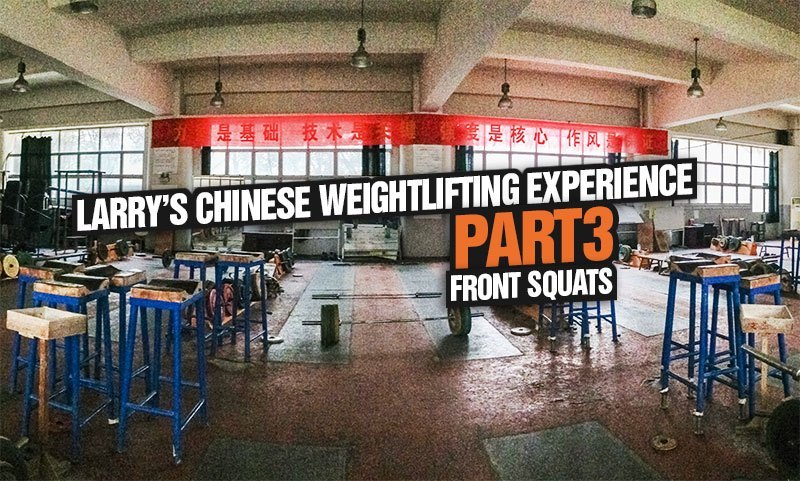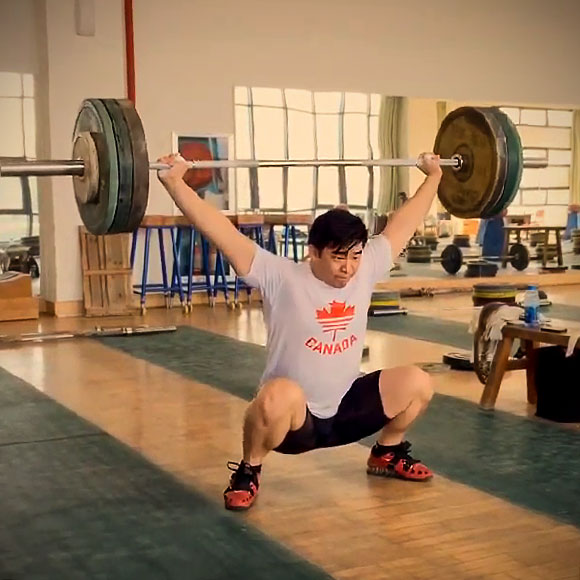Here is Part 3 of Larry’s Chinese Weightlifting Experience series. This one is all about Front Squats. From rack position, over torso strength to knee tracking.
- Part 1: Snatches & Squats
- Part 2: Clean & Jerks + Pulls
Preface
I made my way to the provincial sports college I was introduced to Coach L. I caught him in the morning when the team did not have a scheduled workout so I was able to have some one-on-one teaching.
He suggested I train Front Squats in the morning and then return in the afternoon to take part in the team workout.
Front Squats
Since my start in the sport, my Clean and Jerk has always been limited by my inability to recover heavy Cleans, which in turn is likely due to my poor Front Squat strength. Coach L instructed me to perform sets of three repetitions with ascending weight. As I warmed up, he could immediately see that the movement was unnatural for me.
Elbows sit wider & lower. Shoulders relaxed. Back does the work
Front Rack Position
He modified my rack position by letting my elbows sit wider and lower rather than squeezing them inwards and up.
He also said to keep my shoulders relaxed and let my back do the work.
I found it surprisingly comfortable when I pointed my elbows slightly outwards – this naturally created a shelf with my deltoids and I did not need to shrug my shoulders to support the bar. In order to create this shelf I allowed my chest to expand and I imagined a lordotic arch in my upper back.
I am seeing a trend with these positioning cues – it seems that reducing the amount of external rotation creates a more stable shoulder position for supporting weight overhead and in the front rack.
it’s beneficial to allow the torso to lean forwards slightly
Coach L. also felt that I kept my torso too upright during the entire movement.
Before this day, I assumed that the ideal Front Squat position was a completely vertical torso. Coach L said this is not the case and that the hips must make room for the torso in the bottom position and so it is beneficial to allow the torso to lean forwards slightly during the entire movement and focus on tightening the back while maintaining hip tightness.
The feet should be placed at shoulder width or slightly wider and pointed outwards to create space in the hips.
squeeze elbows up and out. not forward.
In the bottom position, he instructed me to raise my chest and push upwards on the bar with my hands. This required the barbell to be held in the palm of my hands rather than the fingertips.
Pushing upwards against the bar aided in maintaining upper back tightness, and despite my torso being leaned forward more than usual, the weight felt very stable and balanced.
Another way to think about this, he said, was to squeeze your elbows up (not forward, upwards) and out. I liken the tension in this position to the initiation of a Sots Press.
Stability & Balance
Much like Coach Fangs advice for Back Squats (read Part 1 here), Coach L emphasized the importance of stability and balance in the hips during Front Squats.
The hips should not travel forwards or backwards and the drive from the legs should be felt evenly throughout the torso.
Tracking of the Knees
As for tracking of the knees, Coach L had a simple answer:
Try not to let your knees touch together when you stand up, because you’d get red lights in competition.
The idea of forcing your knees either outwards or inwards on the recovery of a Squat or Clean seemed strange to Coach L.
the priority is to stand up with a tight back
He said this is not something the athletes or coaches here think about, and that the priority is to stand up with a tight back because that will make the weight feel the lightest.
Whether a lifter’s knees stay over the feet or travel either inwards or outwards was solely dependent on what felt the most natural to the individual, and the movement of the knees was never forced.
He did, however, admit that probably most lifters in China keep their knees in the same direction as their feet during a Squat, but this was never something he paid attention to and so he cannot say for sure.
Back Squats were preferred
Coach L did not feel that training the Front Squat was a priority for weightlifters.
He explained that Front Squats were only chosen over Back Squats when they wished to reduce the workload on the legs in a particular workout, or to train the positioning and technique of the movement if it was a glaring weakness for the lifter.
Otherwise, Back Squats were preferred. Front Squats are always trained in sets of three repetitions or less.
Torso Strength
Torso strength plays a tremendous role in the Front Squat – Coach L specifically pointed to the obliques and upper back.
The exercises he recommended include side bends, Seated Good Mornings [Video], GHD Hyperextensions, Rack Supports, partial Front Squats from pins, Jerk drives, and push press. As a side note, these are all common exercises that I saw being performed by the majority of the lifters there.
Here is a video showing some of these exercises.
Not the best angle, but you can see some of the common accessory exercises done on a frequent basis: Jerk Supports in a power rack; Hyperextensions; Seated Good Mornings. Accessory work was always done with 6 sets
Jerk Dips
This can be done with 60kg heavier than Jerks and are often done following Cleans, Jerks, or Front Squats for 10 sets of 3-5 reps. This is used to strengthen the posture as well as train balance in the dip and drive
Use of Belts
only use the belt when you lose tightness in the back
I asked Coach L about the use of belts during Squatting and his suggestion was to only use the belt when you lose tightness in the back.
The belt should be tightened such that you must completely retract your abdomen in order to buckle the belt, but not too tight to the point where breathing becomes uncomfortable.
The Chinese prefer belts made of leather, rather than nylon and velcro, because the leather belts are proven to be effective throughout the history of the sport and it is unnecessary to introduce new equipment to replace things that are already effective.
Summary
Technique cues:
- Rack position – elbows down and out, shoulders relaxed, upper back arched
- Torso position – slightly forward, full back tight
- Bottom position – tension from the shoulders and arms to support the bar
- Recovery – stand up naturally and with a tight back, knee positioning is not important
Programming Suggestions
Secondary exercises for Front Squat:
Bodybuilding Exercises for Front Squat:


I have been looking forward to this update on the series since you posted number 2. I can not get enough of the ideology and cues that are taught in China. A lot of the cues and ideas are almost totally opposite of what I have been taught in the US. Thank you for writing about your experience. I tried the front rack position sitting in my office chair and I felt so much stronger and stable, I can not wait to try it under weight. Again, thank you Larry for writing the guest blogs and thank you Gregor for putting together such an amazing website.
Thanks for another interesting article on your experience in China 🙂
Interesting point/cue on the front squat/rack position about the bar being in the hands versus the fingers. Reminds me of the irradiation/co-contraction that powerlifters use in the bench press to create full body tension.
can you explain irradiation/co-contraction?
Irradiation/co-contraction is just the name given to the technique were full body tension is generated by engaging multiple muscle groups to help increase stabilization. A very common example would be the indication to squeeze or crush the bar on your bench press attempt to help create a more solid or controlled feeling during the movement. Another would be to create tension in your abdominal/lower back area during squats to not loose position and transfer the most amount of force to the bar.
Interesting. Does Coach L’s suggestion of lower elbows and bar more in the palms than on the fingertips also translate to the clean recovery?
this must be one of the greatest series out there. well written and full of nice anecdotes and general training information…
I wish somebody would do something equal with e.g. the russians and bulgarians.
What about foot positioning? Externally rotated slightly, or feet pointed straight forward?
“The feet should be placed at shoulder width or slightly wider and pointed outwards to create space in the hips.”
This is a great series. I especially like how some of the information and training seems to contradict Western methods and teachings.
This series is all really interesting! Thanks for posting all this. The discussion on the front rack is something I wish you’d expand on. I’m trying to get a handle on exactly how your front rack position has changed. I’d love to see photos or better yet, a video where you demonstrate the differences between your previous front rack position and your new position.
Thanks,
Kyle Norman
I agree. Please explain more on the relaxed shoulders part. I can understand not shrugging so much and not keeping the elbows so high. Many lifters make a big transition from the rack position to a wider, lower -elbowed drive position for the jerk but I’m not understanding relaxing the shoulder.
Interesting that in China the front squat is only pursued when they need to provide relief in intensity from back squat, or if a lifter has glaring weakness in this position. Sounds like they believe that from a strength/musculature point of view it is not a vital lift when HB back squat can be done.
I’d hazard a guess that this is because their lifters naturally gravitate toward having strong squats and weak(er) pulls. In powerlifting, there are many fantastic Asian squatters and very, very few good dead lifters. Whether this has to do with muscular strength or leverages I’m not sure, but I’ve also noticed that the Asian lifters I’ve trained are naturally quite good at squatting.
Love this series. Could not stop reading. I’ll probably reread this before my training tomorrow. Very inspiring.
I keep coming back to these three articles…
I’ve always felt it was a shame that they were never followed up with more articles.
Any chance of this Gregor/Larry?